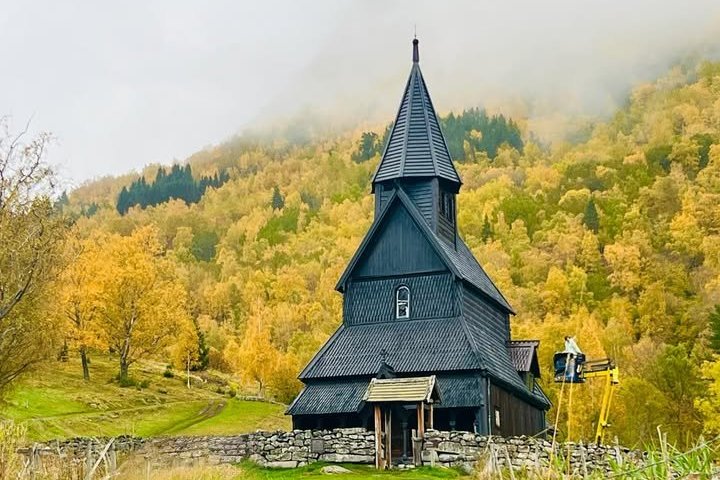
My friends and I began our visit to the Urnes Stave Church in the small town of Sogndal, nestled deep within Norway’s fjord country. Most travelers heading to Urnes would simply drive to the nearby village of Solvorn and take the short ferry across the Lustrafjord to Urnes or Ornes. But instead of following the usual route, we decided to take the long way around, driving along the fjord through Skjolden and looping down the opposite side toward Urnes.
It turned out to be one of the most memorable drives of our trip. The road was narrow and winding, hugging the edge of the Lustrafjord as it curved through small farms, forests, and quiet hamlets. Often it narrowed into a single lane where two cars could barely pass. The scenery was breathtaking: steep green slopes plunging into deep blue water, occasional glimpses of waterfalls, and scattered wooden houses clinging to the hillsides. At times, the road led into dark, one-lane tunnels carved straight through the rock, where headlights illuminated only a small circle ahead. The air inside felt cool and damp. It was nerve-racking, yes, but also strangely beautiful. As we approached the small village of Ornes at the end of the fjord, the road climbed gently uphill through clusters of houses and farms. Only then did the Urnes Stave Church come into view, a modest, dark wooden structure standing quietly on the slope above the fjord. From a distance it looked simple, almost humble, but up close its details revealed a remarkable artistry. Built in the 12th century, Urnes is considered the oldest and most refined of Norway’s stave churches, combining Viking-era ornamentation with early Christian symbolism.
When we visited, it was the off-season, so the church was closed to visitors. We could only admire its exterior. Even so, standing outside was enough to feel its power. The richly carved wooden panels on the north wall and a single column display intricate Viking ornamentation, serpents and vines twisting in endless motion, their lines fluid and rhythmic. The style clearly reflects the Norse artistic tradition, where animals and plants merge into a symbolic struggle between chaos and order, life and death. These carvings, weathered yet still sharp, felt almost alive, carrying the touch of craftsmen who worked here nearly nine centuries ago. Compared with other stave churches in Norway, such as Lom or Heddal, Urnes appears more restrained in form. Its roof ornamentation is surprisingly plain, lacking the dragon-head finials and elaborate tiered gables that give other churches a more dramatic silhouette. Yet this simplicity gives Urnes a quiet dignity. Its beauty lies not in grandeur but in the refinement of its carvings and the subtle harmony between structure, landscape, and light. Around the site, a worker was spraying a black coating onto the wooden walls, perhaps a kind of protective tar or wax used to shield the timber from the elements. Watching him at work was a reminder that this church, though ancient, is still being cared for, its survival dependent on generations of preservation and devotion.
The best view of the church, however, is not from the front but from the small hill behind it. From there, the dark wooden form of Urnes stands out strikingly against the bright blue of the Lustrafjord and the soft green slopes beyond. The contrast between the blackened church and the luminous landscape makes the scene unforgettable, a perfect balance between human craft and natural grandeur. Standing there, with the fjord shimmering below and the mountains beyond, my friends and I felt an almost spiritual calm. The long, slow journey to reach it made the experience even more rewarding. While most visitors arrive by ferry in just a few minutes, our detour around the fjord turned the trip into an adventure, one that revealed the quiet beauty and rugged soul of this corner of Norway.
More on
Comments
No comments yet.
